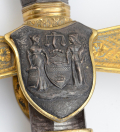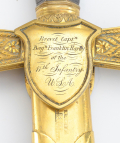site search
online catalog
FIVE BATTLES, A BREVET, AND A DUEL WITH MISSISSIPPI RIFLES AT THIRTY PACES SUPERVISED BY STONEWALL JACKSON - THE MAGNIFICENT MEXICAN WAR PRESENTATION SWORD OF BREVET CAPTAIN B.F. HARLEY 11th US INFANTRY

$20,000.00 SOLD
Quantity Available: None
Item Code: 870-448
This beautiful and historic sword was presented to Brevet Captain B.F. Harley by his “fellow citizens” of Philadelphia upon his return from service in Mexico and bears the city’s coat of arms on silver plaque applied to the obverse shield-shaped langet, with Harley’s name, rank and regiment on the reverse, and a beautiful, lengthy presentation on the scabbard.
The sword is a very high grade and relatively early work by Horstmann, stamped “W.H.HORSTMANN / & SONS / MAKERS” on the scabbard upper reverse. The gilt brass hilt and scabbard preserve better than 90 percent of their original gilt finish. The pommel is cast and chased with floral decoration, urn-shaped but reminiscent of a flower bulb in outline, something picked up in the foliate scabbard engraving. Set in the pommel cap is a large amethyst. The crossguard is cruciform, with flat, flaring quillons bearing an eagle with U.S. shield on its chest at either end on both sides. The kuckleguard consists of a woven chain of flat metal ribbons, from pommel cap to tip of one quillon, likely gilt originally, but with loss of finish from flexing. The grip is octagonal, silver, engraved on each face with floral scrolls, leaves and berries, along with patriotic and martial elements such as a U.S. shield and quiver. Shield-shaped langets extend from the quillon block on both sides. The obverse bears a separately applied silver plaque with the arms of the City of Philadelphia. The reverse langet is engraved, “Brevet Captn / Benjn. Franklin Harley / of the / 11th Infantry / USA” in beautiful script and block letters between flourishes. The silver grip and plaque have a matching, mellow, aged patina. The plaque has raised slightly at the upper edge, but is secure.
The scabbard is plain on the reverse and elaborately decorated on the obverse. Like the hilt, it has better than 90 percent of its gilt finish and is fitted with two carrying rings with the ring mounts cast and chased with an eight-pointed star in a wreath, flanked by split fans of leaves. The drag has a similar split fan at top and long leafy branch extending the tip. The blade of the drag is rendered as two sea serpents meeting face to face at bottom with open mouths, giving the distinct impression of smiles. The raised panels of the ring mounts and drag mark off two, long engraved panels on the scabbard body. The lower panel features a large eagle with stars and glory overhead, sitting on a U.S. shield. Below this extends a long grape vine sprouting leaves and clusters of grapes at five points. The same motif of grapevines, leaves, and grapes frames the beautiful engraved presentation in the upper panel: “Presented to BREVET CAPTn BENJAMIN FRANKLIN HARLEY of / Philadelphia by his fellow Citizens for the promptness shown in the offer of his services to / his Country and for his Gallant conduct in the Battles of Contreras, Churubusco, and / Particularly at Molino del Rey, at the capture of Chapultepec, the Garita San Cosme/ and the final capture of the City of Mexico / Philadelphia Oct. 26, 1848.”
The blade is spadroon form, with central fuller and spearpoint. The edge and point are good. Both sides are etched. The etching is fully visible and legible, though soft from wiping down over the years. The obverse has an urn at bottom from which a leafy branch extends to a lengthwise cartouche with flamboyant ends containing a “U.S” surrounded by stars. The reverse has a similar foliate motif, but surmounted by a eagle with raised wings clutching arrows and olive branch, and holding in its beak a scrolling ribbon with a dry-point etched “E Pluribus Unum.”
Benjamin Franklin Harley (ca.1815 to 1853) was a Philadelphia businessman and merchant. He jointly held an 1844 patent for a new method of casting iron hinges, and by 1845 is listed in the city directory with that as a specialty. He almost certainly was involved with the prewar militia: the Cadwalader Greys and 1st Troop Philadelphia City Cavalry attended his funeral in 1853 according to bills in his probate file. He received a commission as 2nd Lieutenant of infantry in the U.S. Army 2 March 1847 and was assigned to the 11th Infantry April 9. This was the third iteration of that regiment, this time as one of ten new regiments raised for one-year’s service in the Mexican War and recruited in Pennsylvania, Maryland, and Virginia. The battle honors of the presentation are a record of his service. He was promoted to 1st Lieutenant 12 August 1847 and is mentioned as one of two officers leading part of the regiment in pursuit of Mexican forces in the attack on a Mexican fort, the Casa Mata, in the Battle of Molino del Rey in September. He also received a brevet to captain to date 10 August 1847 for “gallant and meritorious conduct in the battles of Contreras and Churubusco.”
After the fighting ended, Harley remained with the army on occupation duty at Mexico City, posted in the nearby village of Lerma. As among the generals, there was conflict among lower ranking officers over credit for wartime deeds. Adjutant D.S. Lee of the 11th apparently authored an anonymous letter to a hometown paper claiming that he had caught up the mortally wounded Colonel of the regiment during the Battle of Molino del Rey, a rather bloody Pyrrhic victory. Harley, however, was recognized in the regiment as the officer beside the Colonel in the fighting, and although on the verge of leaving for home on a ninety-day leave, he denounced Lee as a liar, accepted Lee’s challenge in response, and thus got to select the weapons: Mississippi rifles at thirty paces. These were apparently obtained from the “Regiment of Voltiguers and Foot Riflemen,” one of whose officers, James J. Archer, later Confederate general, witnessed the duel on 3 May 1848 along the road between Lerma and Mexico City.
Lee chose two fellow Viriginians seconds. One was Thomas Jonathan Jackson, then serving as an artillery lieutenant. Jackson “won the word” by one account, meaning that he supervised the proceedings, and apparently laid out the rules in no uncertain terms, drilling the participants, like the “awkward squad.” Archer recounted the duel in a letter just two days later: “They fought at sundown near Lerma, with Voltigeur rifles at thirty paces — standing with their rifles slanting downwards at an angle of 45 degrees, and firing between the words "fire, one two, three, stop " — neither hit — after the first fire Lee's friend Lt. Jackson of the Lt. Artillery expressed himself satisfied and the parties left the ground without, however, any apology or retraction from Harley, who was very anxious for another shot — This he had no right to ask, having gone out to give, not to receive satisfaction and, when a man says he is satisfied, you can not well insist that he is not satisfied enough, especially when satisfying him any more might injure his health.”
Archer apparently understates Harley’s anger at not resuming the fight: he added the label of “thief” to his accusation against Lee, on the ground that Lee had stolen his legitimate claim to “bravery and soldierly devotion” by one account. There was no follow-up, however: Harley was on his way back to the states by May 21, where he was to testify at a courtmartial and was honorably mustered out 13 August 1848.
Harley received the sword in October and may have married during this period as well. Information is sketchy, but his will mentions his wife, Catherine. He did not stay in Philadelphia long, however: by February 1849 the Gold Rush was on and he was advertising in the Philadelphia papers for members to join a company headed to the California. Prospecting may not have worked out, but by 1850 we find him as deputy sheriff in San Francisco, where he remained until late 1852. With vigilante and gang activity at the time, must have been a figure of some authority. He was licensed to own a “powder house,” where residents were obliged to store any gunpowder in amounts over 25 pounds and he is once referred to as holding several hundred muskets for the militia. Harley returned to the east coast by the packet steamer “SS Illinois,” docking in New York in January 1853, and died just a month later in Philadelphia, on February 11. Newspapers gave his age as 38. Other records say 37 years, 6 months. He left several properties in San Francisco to his wife and to his mother. He also left behind one impressive sword. [sr] [ph:m]
~~~~~~~~~~~~~~~~~~~~~~~~~~~~~~~~~~~
THIS ITEM, AS WITH ALL OTHER ITEMS AVAILABLE ON OUR WEB SITE,
MAY BE PURCHASED THROUGH OUR LAYAWAY PROGRAM.
CLICK HERE FOR OUR POLICIES AND TERMS.
THANK YOU!
Inquire About FIVE BATTLES, A BREVET, AND A DUEL WITH MISSISSIPPI RIFLES AT THIRTY PACES SUPERVISED BY STONEWALL JACKSON - THE MAGNIFICENT MEXICAN WAR PRESENTATION SWORD OF BREVET CAPTAIN B.F. HARLEY 11th US INFANTRY
For inquiries, please email us at [email protected]
Most Popular
Historical Firearms Stolen From The National Civil War Museum In Harrisburg, Pa »
Theft From Gravesite Of Gen. John Reynolds »
Cavalry Carbine Sling Swivel »
Fine Condition Brass Infantry Bugle Insignia »
featured item
VERY SCARCE 1799-1800 SWAN CONTRACT VIRGINIA MILITIA REGIMENTALLY MARKED MUSKET: 42nd REGIMENT, PITTSYLVANIA
This musket is stamped “42. VA. REGT. PITTSYLVANIA” on the barrel, was later altered to percussion and then shortened for use in the civilian market. It is a scarce survivor from muskets delivered to Virginia by Jame Swan of Boston in January… (1000-241). Learn More »
















